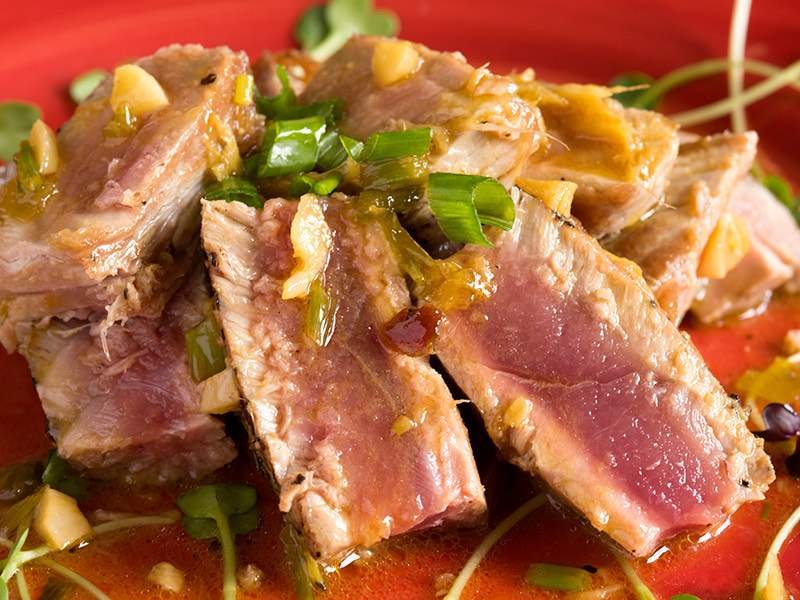Your Essential Guide to Tuna

Tuna is one of the most consumed fish in the United States, and for good reason. Its unique flavor and versatility have made it a favorite among home cooks and chefs alike.
But not all tunas are created equal. There are different kinds of tuna, different grades of tuna, and even different ways tuna are caught, processed, and sold. Our Head of Quality Control, Robert DiGregorio, aka Bobby Tuna - that's right! - is a widely recognized tuna expert and author of Tuna Grading and Evaluation, so who better to guide us through the different types of tuna than Mr. Tuna himself?
What is the Difference in Tuna Types?
First, the most widely consumed tuna in the United States is canned tuna. What canned tuna is, exactly, varies. Solid White and Chunk White are always albacore tuna, a very mild, firm, light-colored fish. Chunk Light is a blend, usually with skipjack, yellowfin, and sometimes bigeye, stronger in flavor and darker in color.
Fun fact: Skipjack makes up the largest component of tuna production worldwide, and most of it is canned and not sold fresh. Yellowfin accounts for 58% of the worldwide tuna catch, followed by bigeye (18%), albacore (17%), and bluefin (7%).
Buying fresh tuna, though, can be more of a challenge, so let’s take a look at the different varieties of tuna. The tunas most commonly sold for loins and steaks are albacore, yellowfin, bigeye, and bluefin.
What are the Differences Between Albacore, Yellowfin, Bigeye, and Bluefin Tuna?
Albacore tuna is usually light pink to dark pink, and this feature alone makes it easily distinguishable from the other tunas. The meat is not very fatty, and this kind of tuna usually sells for less compared to the others. In fact, albacore is the only tuna that can be truly called “white tuna”. Next time you see “white tuna” on a menu, ask to make sure it’s really albacore. Very often, a fish called escolar is used, and escolar can cause severe digestive problems. Albacore is also not graded like other tuna, but is sold just as other fish are sold. If it’s a high-quality product, it will command a higher price. Simple.
Yellowfin, bigeye, and bluefin tuna are scrutinized much more closely. Generally speaking, bigeye tuna tend to be fattier than yellowfin. Their color, again, generally speaking, may be a darker red as well. Yellowfin tuna can be a brighter, lighter color. Bluefin tuna are considered the most valuable because they can store a lot of fat in their musculature, and this means greater flavor and texture.
What is the Difference Between Yellowfin and Ahi Tuna?
Trick question! Yellowfin and ahi tuna are the same - ahi is the Hawaiian name for yellowfin tuna.
What is the Difference Between #1 and #2 Tuna?
Let’s look at the criteria and differences between the tuna grades. Tunas are commonly graded as #1, #2+, #2 and #3. Sometimes, you will see grades like 2-, 2G, 1-, 1+, or even letter grades, but we’ll just consider the grades most often used by tuna traders.
What is #1 Tuna?
Regardless if it’s yellowfin, bigeye, or bluefin, #1 tuna must exhibit high fat. The presence of fat will appear as marbling in the meat and near the skin. The texture will have a sticky feel to it, and the color should be red, shiny, and translucent. This is the best grade for all raw applications - sushi, crudo, etc.
What is #2+ Tuna?
#2+ tuna may exhibit fat as well but are generally leaner than #1. The texture should be wet and smooth but not so sticky. #2+ tuna will not display the even red translucent color of #1s but will still have good color and brightness. This can also be used in dishes calling for raw tuna.
What is #2 Tuna?
At one time, #2 tuna was the most popular tuna for restaurants, but with the popularity of sushi and sashimi, #1 and #2+ grades have taken a bigger share of the tuna market. The presence of fat in #2 tuna will most likely be minimal. Typically, fat is not evident in the meat or near the skin. The color, while still red, will be uneven and not exhibit the brightness and clarity of #1 and #2+. #2 tuna can be used for all cooked tuna recipes but is not typically eaten raw.
What Does Tuna Taste Like?
Tuna is a rich, meaty fish. #1 tuna has a silky, melt-in-the-mouth texture thanks to its high fat. #2+ tuna has a similar texture but is less tender. #2 tuna is mild and firmer.
How to Cook Tuna?
#1 tuna is best treated simply, either raw or rare, in poke, tartare, or quickly seared. #1 and #2+ are a favorite in Japanese tuna recipes like sushi and sashimi. #2 can be seared, poached, grilled, or roasted, but because it is lean, be careful not to overcook, or it will be tough and dry.
What are the Health Benefits of Eating Tuna?
Tuna is high in protein and omega-3 fatty acids, which means it’s good for heart health and may help reduce cholesterol. Tuna is a great choice for keto, Whole30, and other high-protein, low-carb diets. Tuna is a good source of Vitamin B, potassium, vitamin D, phosphorus, selenium, and magnesium.
Our Favorite Tuna Recipes
Seared Tuna Nicoise Salad Recipe
This colorful salad is usually made with canned tuna, but searing our fresh wild tuna makes for a melt-in-the-mouth upgrade. One taste of our seared tuna nicoise salad recipe will transport you to the south of France without leaving home.
Pan searing tuna has never been easier with this seared Asian tuna recipe. Use our fresh Ahi Tuna for a real standout meal.
Tuna Tartare Asian Inspired Recipe
Enjoy this delicious Tuna Tartare Asian Inspired recipe that will leave you wanting more. Try it with our fresh Ahi Tuna!



